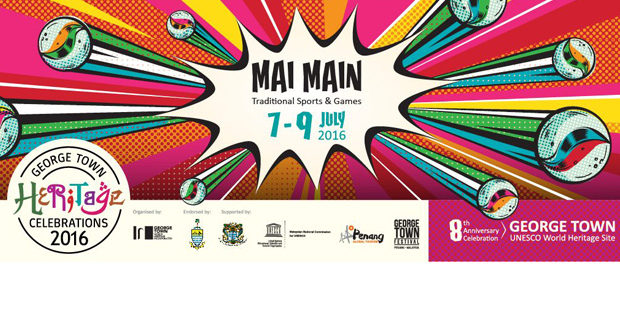
‘Mai Main’ George Town’s traditional sports and games
It was all fun and laughter in the evening of the George Town Heritage ‘StreetFest’ Celebrations. The ‘Mai Main’ or ‘Let’s Play’ Streetfest was part of the 8th anniversary celebration of George Town’s inscription as a UNESCO World Heritage Site where the young and old alike flocked the old streets of George Town to play the traditional sports and games from the multicultural community of Penang. Parents are seen showing their children how to play their childhood games and that fun can be found outside of technology.
Here are our top 10 favourites:

1.HOPSCOTCH
A series of sequenced squares are drawn on the floor with chalk and players will hop on the squares using one or two legs based on the sequence The 1-1-2-1-2 squares sequence is usually used but it is free to the players to design their own square grids. At the beginning of each round, a stone will be discarded to one of the numbered squares that correspond with the sequence of the round. The player cannot land his or her leg onto the square where the stone lands. A round is complete when a player hops over all the squares and retrieve the discarded stone.

2. SEPAK RAGA
Played within the compound a court and with a rattan-weaved game ball, this traditional Malay game, usually malecentric, involves a skilful coordination of various body parts, mainly the legs, barring the arms and hands, to deflect the ball from player to player.

3. BATU TUJUH
This is a game of dexterity and balance of the coordinated movements of hand and eyes. Popular among women of all cultures, players will toss and catch a group of seven stones through varied techniques. One of the techniques is known as ‘timbang’ or ‘weighing’ where the player must toss a stone, flip her palm once to weigh the stone on the back of her palm, and then catch the stone on the second flip of the palm.

4. GASING
Gasing is the Malay lingo of the spinning top. Equipped with a rotary gear (usually made of wood), players will attempt to keep the top spinning for as long as possible. Before the start of a game, players will tie a cotton string around the rotary gear to facilitate its release. To win the game, the player must topple the opponent’s top with his or her own spinning top.

5. PICK-UP STICKS
A bunch of colourful and slender plastic sticks will be dispersed by a player, holding a handful and then releasing them from the grip onto a table. Other players are then required to skilfully remove each stick from the stack without moving the other sticks. Players are only allowed to use their bare finger, or from a stick he or she picked, to aid in the removal.
To make the game more challenging, players can opt to only use the stick of the same colour to pick a similarly coloured stick.

6. CONGKAK / PALLANGGULI
Congkak is a folk game of the Malay community that uses an elongated, boat-shaped vessel with 10 or 14 holes. It is normally made of wood. Players will strategise to capture as many seeds (marbles, cowry shells, saga seeds) as they can in each round, and to ensure those seeds are transported to their own ‘storehouses’ to win the game. Another variation of the game is called Pallangguli which uses a rectangular- shaped vessel of 14 holes. The difference between the two games is that the ‘storehouses’ of congkak is at both ends of the vessel while pallangguli’s ‘storehouses’ are in the middle of the vessel.


7. GULI
Using marbles as the arrows and the fingers as the bow, each player will take turn to flick a marble to a pool of grouped marbles in a heap of sand, aiming to get as many marbles as possible out from the designated area. These marbles become their tokens at the end of each game.

8. THAYAM/CHUKKINI
This strategic game-of-chance with Hindu origin revolves around the use of a pair of dice and seeds. Players will toss the dice to determine the steps to be taken on the board and once a player reaches the final destination, the game is concluded. Along the way, player will have the chance to eliminate the seeds of other players as well. It shares a similar concept to the Ludo board game. While Thayam and Chukkini are of the same mechanics, the shape of the dice and the rules of each are different from one another. The board of Thayam and Chukkini are usually carved on wood or drawn using chalk on flat surfaces, the difference is that Chukkini’s board has extra grids, the outer hills on the four sides of its larger square.

9. ANIMAL CHESS
A Chinese-origin strategy board game featuring various animals on the round chess pieces – each animal has its own hierarchy in which the stronger animal will eliminate the weaker ones. Unlike the Western chess, players are constrained to a one-square movement of forward or backward, and no diagonal moves. The goal is to avoid being ‘eaten’ by your opponent’s animals and move one of your pieces to reach the ‘house’ on the opponent’s side of the board. However, around the ‘house’ is a three-pronged square used to trap the opposing side where animals will have no power in their hierarchy.
10.SKIPPING ROPE
A popular game played by boys and girls of all cultures. There are several ways of playing that involve players crossing or jumping over a rubber band-made rope. Usually two players will hold each end of the rope, and the other players will take turn to skip over it.



 Previous Article
Previous Article Next Article
Next Article